|
-
15th January 11, 01:16 AM
#1
Derrick's The Image of Irelande (1581) & Irish Clothing
Derrick's The Image of Irelande (1581) pt.1
The following images are woodcuts that appeared in the book The Image of Irelande by John Derricke, and published by John Daye in London in 1581.
Derricke was believed to have been a retainer to Sir Henry Sidney & was an eyewitness to the events in Ireland during this period. While the book is most certainly Sassenach propaganda, it is considered by most historians to be an important work illustrating Irish costume and customs and the English military during the Tudor period.
Also included are both period illustrations and modern interpretations of the Irish léine and of the warriors known as the Galloglass.
From the website: The Image of Irelande, by John Derrick (London, 1581) - Plates
The Edinburgh University Library copy of "The Image of Irelande, with a discouerie of VVoodkarne" was gifted by the poet William Drummond of Hawthornden, one of the early graduates of the Tounis College to his alma mater. The woodkarne, or woodkerne, were a semi-nomadic people, perceived as living by plunder and bloodshed like the Border Reivers in the Debatable Land between Scotland and England at the same period.
The EUL copy is unique in having a complete set of the woodcut plates, which provide important illustrations of Irish costume and custom and of English military gear of the late 16th century. Like a strip cartoon, the plates tell the story of the subjugation of the Irish rebels by Sir Henry Sidney, Lord-Deputy of Ireland under Queen Elizabeth of England (and father of the poet Sir Philip Sidney whose "Arcadia" was greatly admired by William Drummond). It was reprinted in facsimile and edited by John Small, Librarian of the University, in 1883.
note: scans of the plates & additional caption descriptions appear courtesy of "The Irish Wars 1485 - 1603" (Osprey Man-At-Arms # 256) and appear in italics. To view an original copy of Derricke's book, see the link above.
The best depictions of Irish warfare in the Tudor period are the series of 12 woodcuts found in Derricke's 'The Image of Ireland', published in 1581 but portraying events during Sir Henry Sidney's second viceroyalty, 1575-78 -- probably his itinerary round Ireland from October 1575 to april 1576. (Osprey Books)
A soldier holding a battle-axe hands a spear to an Irish chieftain in full dress, with a page holding the chieftain's horse. Note the pillion saddle of the horse.
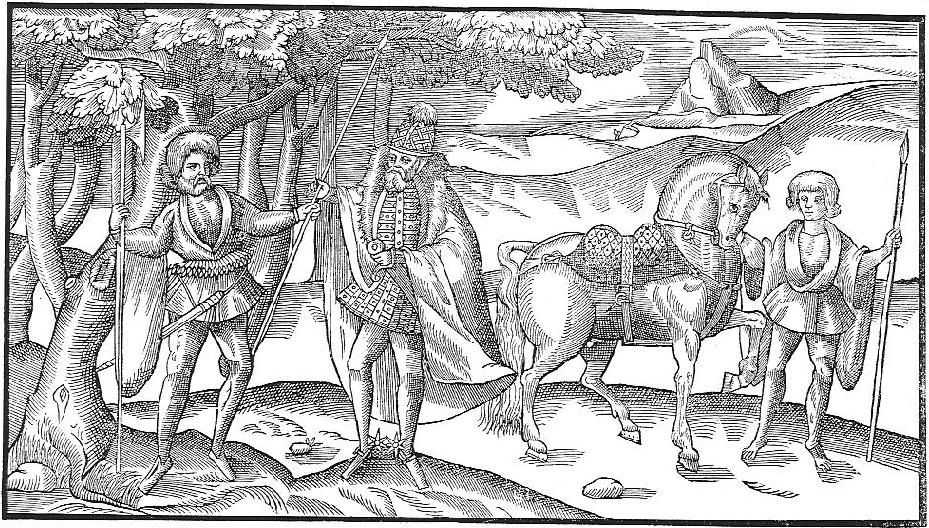
An armed company of the kerne, carrying halberds and pikes and led by a piper, attack and burn a farmhouse and drive off the horses and cattle. Derricke's original caption observes that 'they spoil, and burn, and bear away, as fit occasions serve, and think the greater ill they do, the greater praise deserve.'
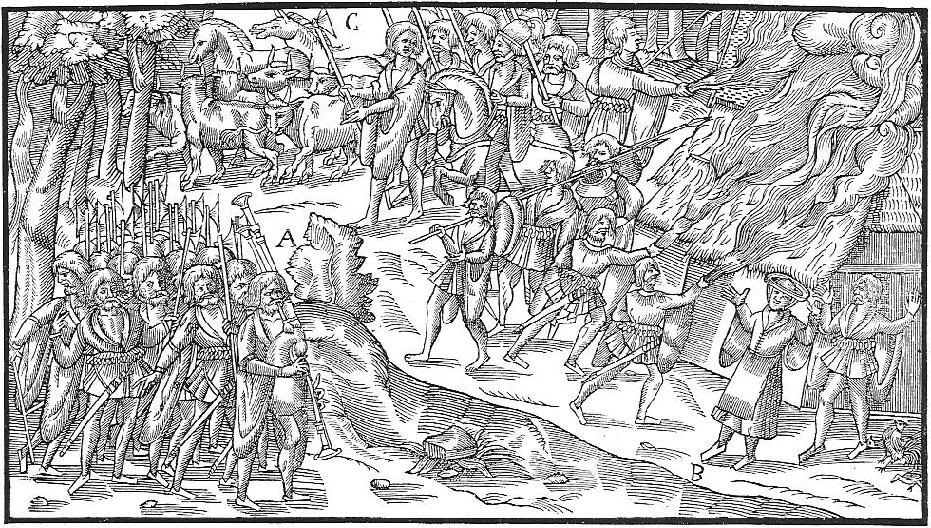
The most famous plate of the set shows the chief of the Mac Sweynes seated at dinner and being entertained by a bard and a harper. The meal of beef is prepared in traditional fashion, being stewed in a cauldron made of its own hide.
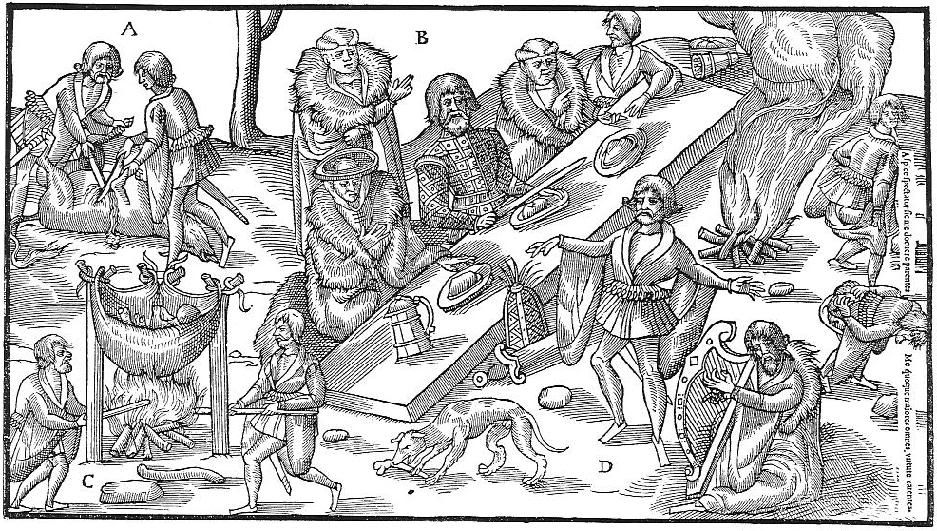
The Irish chieftain receives the priest's blessing before departing to fight the English, who are shown in full armour. To the right the raiders are repulsed by English troops, who recapture the rustled livestock.
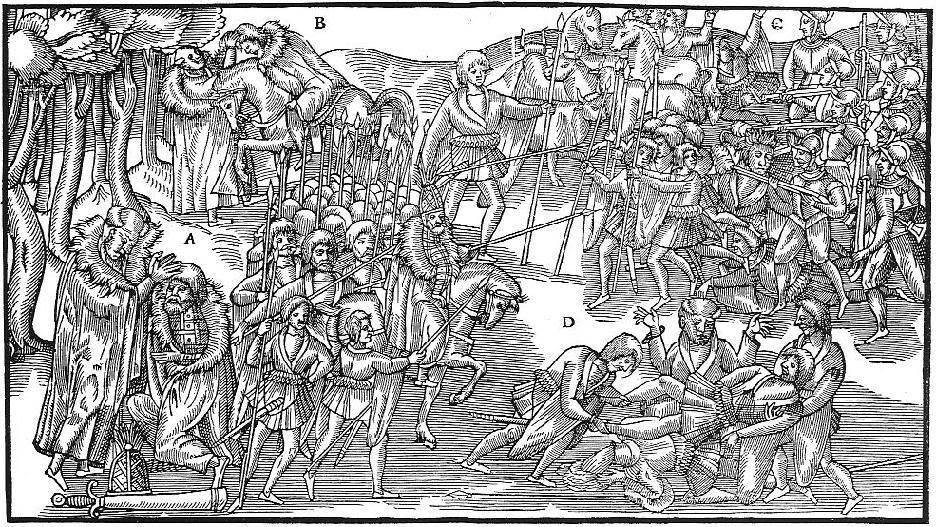
The English solders return in triumph with 'liberated' livestock and Irish prisoners, carrying severed Irish heads and leading a captive by a halter. Note the adoption of Irish practice in the taking of enemy heads.
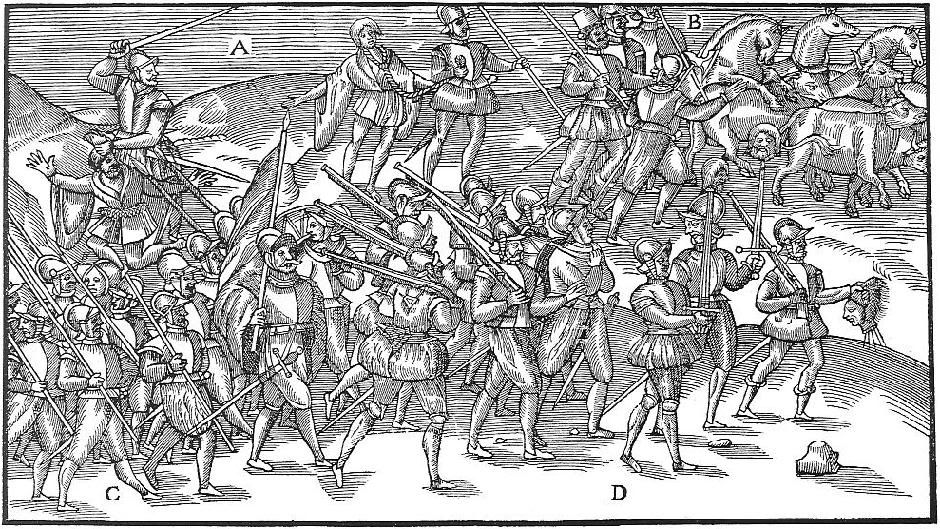
Sir Henry Sidney, Lord-Deputy, accompanied by an armed force, sets out from Dublin Castle for a progress through Ireland. Note impaled rebel heads above the gateway.
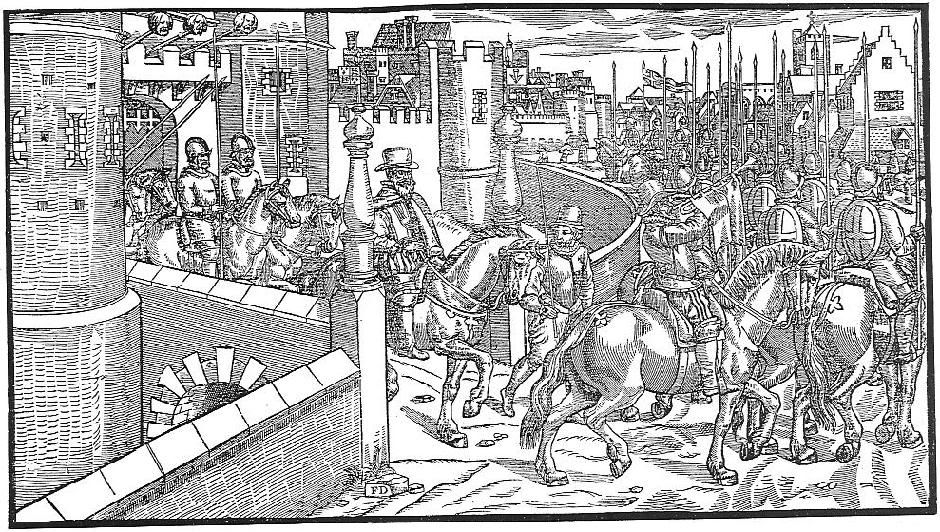
Last edited by BoldHighlander; 15th January 11 at 01:26 AM.
[SIZE="2"][FONT="Georgia"][COLOR="DarkGreen"][B][I]T. E. ("TERRY") HOLMES[/I][/B][/COLOR][/FONT][/SIZE]
[SIZE="1"][FONT="Georgia"][COLOR="DarkGreen"][B][I]proud descendant of the McReynolds/MacRanalds of Ulster & Keppoch, Somerled & Robert the Bruce.[/SIZE]
[SIZE="1"]"Ah, here comes the Bold Highlander. No @rse in his breeks but too proud to tug his forelock..." Rob Roy (1995)[/I][/B][/COLOR][/FONT][/SIZE]
-
-
15th January 11, 01:18 AM
#2
Derrick's The Image of Irelande (1581) pt.2
The English army is drawn up for battle, while Sidney himself parleys with a defiant messenger from the Irish.
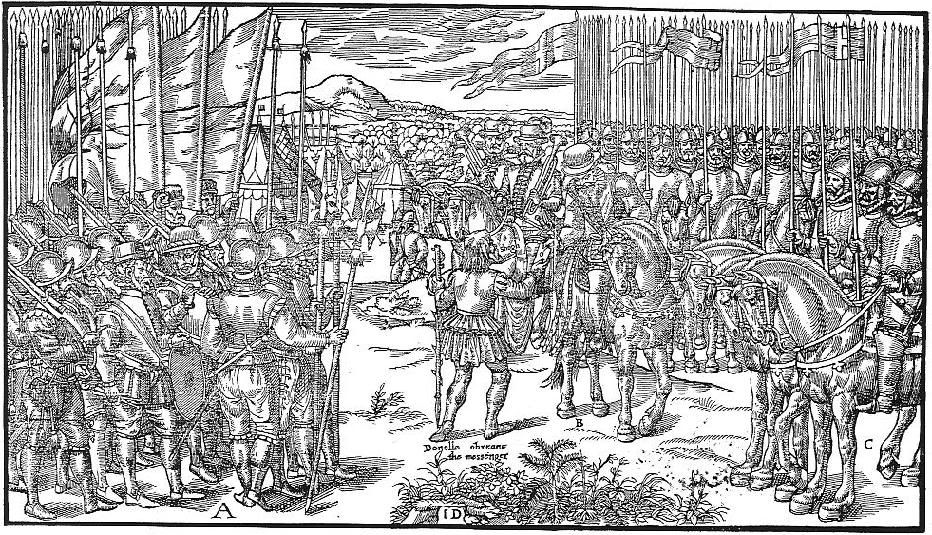
Sidney and the English army on the march with standards and trumpets, pikemen and shot in the foreground, demilances behind.
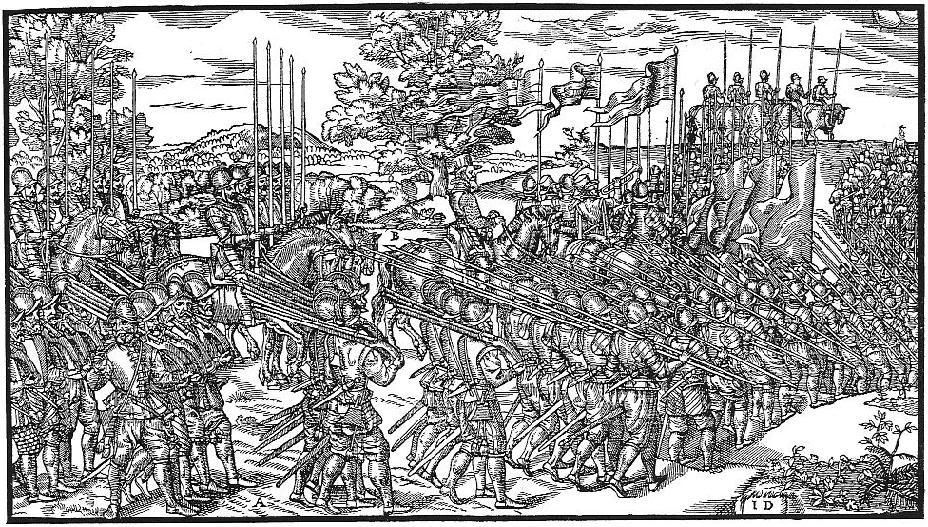
The English army puts the Irish army to flight. The piper is cut down with his pipes beside him.
Spirited action between English and Irish cavalry. In the background mail-armoured galloglasses flee into the woods to escape the withering fire arquebusiers.
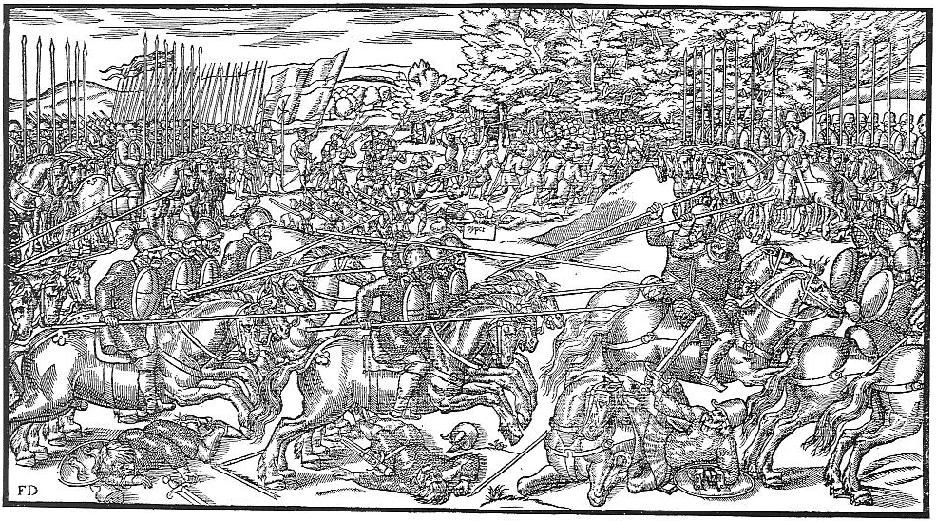
Sir Henry Sidney returns in triumph to Dublin Castle , April 1576, and is received by the Lord Mayor and Aldermen.
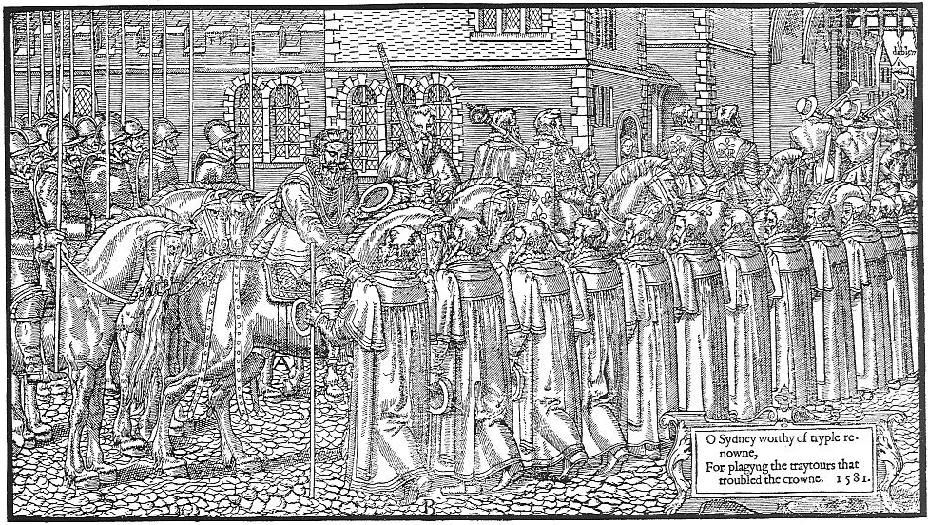
Rorie Oge O'Moore, a wild kerne and a defeated rebel leader, in the forest with wolves for company. He was eventually killed by the kern of Barnaby Fitzpatrick, Lord of Upper Ossory, in June 1578.
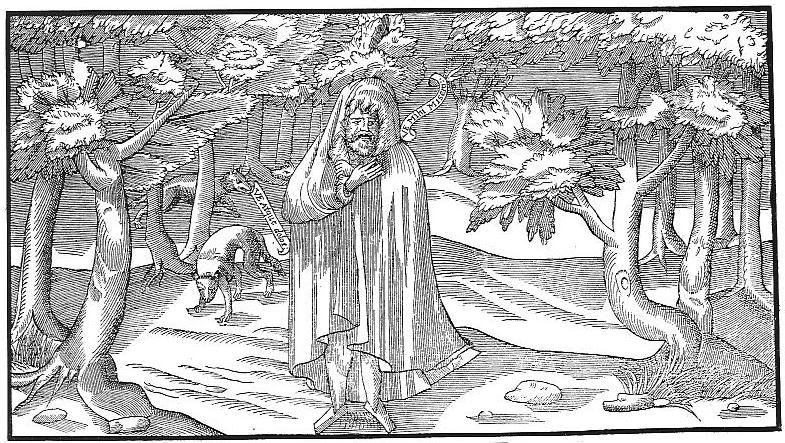
Turlough Lynagh O'Neale and the other kerne kneel to Sidney in submission 1575. In the background Sidney seems to be embracing O'Neale as a noble friend. Note that O'Neale wears a native version of English costume and sports an English haircut, though his entourage still wears distinctive Irish costume.
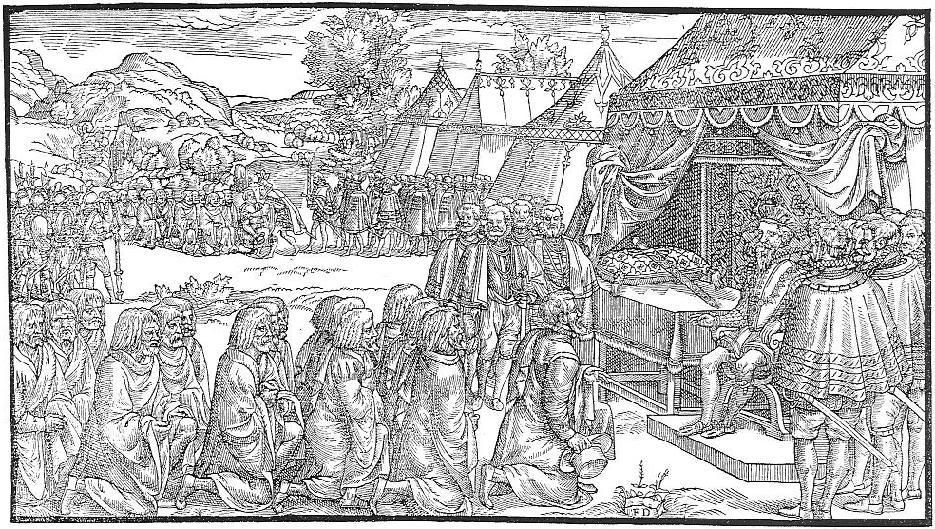
[SIZE="2"][FONT="Georgia"][COLOR="DarkGreen"][B][I]T. E. ("TERRY") HOLMES[/I][/B][/COLOR][/FONT][/SIZE]
[SIZE="1"][FONT="Georgia"][COLOR="DarkGreen"][B][I]proud descendant of the McReynolds/MacRanalds of Ulster & Keppoch, Somerled & Robert the Bruce.[/SIZE]
[SIZE="1"]"Ah, here comes the Bold Highlander. No @rse in his breeks but too proud to tug his forelock..." Rob Roy (1995)[/I][/B][/COLOR][/FONT][/SIZE]
-
-
15th January 11, 01:20 AM
#3
-
-
15th January 11, 01:21 AM
#4
-
-
15th January 11, 01:22 AM
#5
Captain Thomas Lee - circa 1594
Captain Thomas Lee, circa 1594, when he was 43 years-old, by the Flemish artist Marcus Gheeraerts the Younger. It was probably commissioned by his cousin, Henry Lee of Ditchley. The subject is shown in the regalia of a captain of the Queen's Kern (a hybrid combination of English & Irish dress), posing with legs and feet bare, and armed with shield, spear and pistol. Lee served in Ireland continuously from 1575 to 1599.
Though it has been suggested that his costume is fanciful rather than realistic, it is on record that some Englishmen genuinely did adopt Irish dress. John Vowell, for instance, records in 1586 of George Bourchier (Sir John Perrott's military adviser) that 'if he served upon foot he was apparelled in the manner of a kern ... and so light of foot as no kern swifter'. Note the characteristically Irish way he holds his javelin, with one finger through a leather loop which enabled it be twisted and spun in the hand.
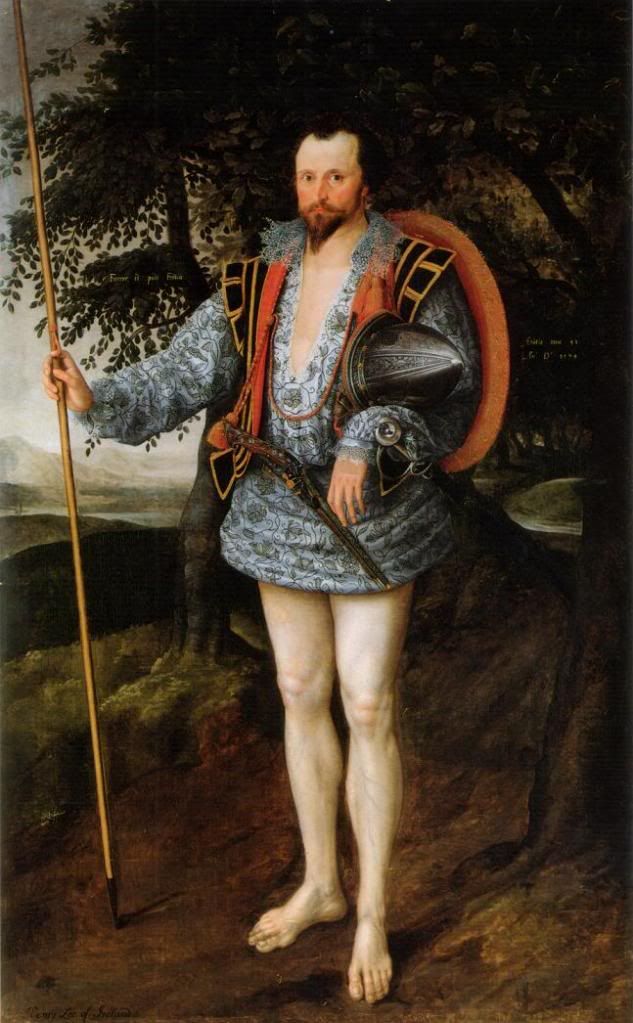
[SIZE="2"][FONT="Georgia"][COLOR="DarkGreen"][B][I]T. E. ("TERRY") HOLMES[/I][/B][/COLOR][/FONT][/SIZE]
[SIZE="1"][FONT="Georgia"][COLOR="DarkGreen"][B][I]proud descendant of the McReynolds/MacRanalds of Ulster & Keppoch, Somerled & Robert the Bruce.[/SIZE]
[SIZE="1"]"Ah, here comes the Bold Highlander. No @rse in his breeks but too proud to tug his forelock..." Rob Roy (1995)[/I][/B][/COLOR][/FONT][/SIZE]
-
-
15th January 11, 01:23 AM
#6
Reconstruction of the Dungiven Bog Find:
Excerpted from "Tartans and Kilts" by the Ulster-Scots Agency:
On April 28, 1956, the Coleraine Chronicle reported the discovery by a farm labourer of ragged clothing dug out of an earth bank on the farm of Mr William Dixon, in the townland of Flanders, near Dungiven, County Londonderry.
The find consisted of a woollen jacket or jerkin, a small portion of a mantle or cloak, trews or tartan trousers, and leather brogues. This was the style of clothing worn by men in those parts in the 16th or 17th century.
Archaeologists from the Ulster Museum were invited to analyse the discovery. A block of peat containing fragments of the clothing was examined.....revealing a high concentration of pine pollen. Scots pine had been introduced into Ireland in the 1600s. The likelihood was that the tartan cloth was at least that old.
The trews had been made up from tartan woven in the Donegal style, in strips varying in width and distance from each other. The remaining items were also subjected to rigorous analysis.
Audrey Henshall (Edinburgh's National Museum of Antiquities) concluded that while the mantle was Irish, the trews almost certainly originated in the Highlands. The logical explanation was that tartan cloth woven in Donegal had been exported to Scotland. There the material had been made into tartan trews, which was the fashion in the Highlands. These trews started off as clothing for some wealthy person. When they unearthed in the soil at Flanders townland, the trews were covered in patches. The large variety of materials used indicated that the trews had been passed from one person to another, adding to the mystery.
The textile expert supported the soil analysis, dating the find to between 1600 and 1650....
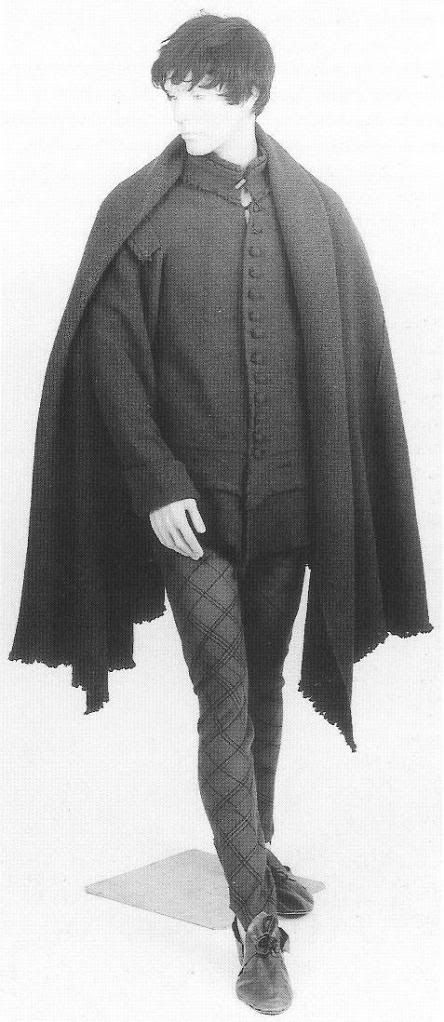
From "The Irish Wars 1485-1603" (Ospery Men-At-Arms #256):
Reconstruction of the Dungiven Costume, a set of clothes discovered in a bog in the 1960s and thought to date to c.1600, the period of Tyrone's rebellion. It was perhaps originally the property of his O'Cahan soldiers. The trousers are of a tartan cloth cut on the bias, while the jacket resembles that of Turlough Luineach O'Neill in Derricke's print. The semi-circular woollen mantle is 8 1/2 feet wide by 4 feet deep.
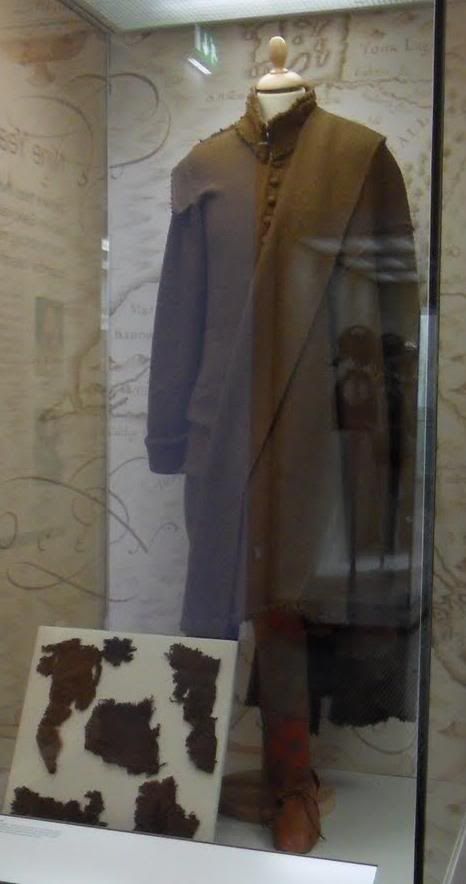
The photos are of the reconstructed Dungiven bog clothing at the Ulster Museum, Belfast.
[SIZE="2"][FONT="Georgia"][COLOR="DarkGreen"][B][I]T. E. ("TERRY") HOLMES[/I][/B][/COLOR][/FONT][/SIZE]
[SIZE="1"][FONT="Georgia"][COLOR="DarkGreen"][B][I]proud descendant of the McReynolds/MacRanalds of Ulster & Keppoch, Somerled & Robert the Bruce.[/SIZE]
[SIZE="1"]"Ah, here comes the Bold Highlander. No @rse in his breeks but too proud to tug his forelock..." Rob Roy (1995)[/I][/B][/COLOR][/FONT][/SIZE]
-
-
15th January 11, 01:25 AM
#7
Modern Interpretations:
The following illustrations are by renowned military history illustrator Angus McBride.
A Galloglass and the kern - circa 1562.
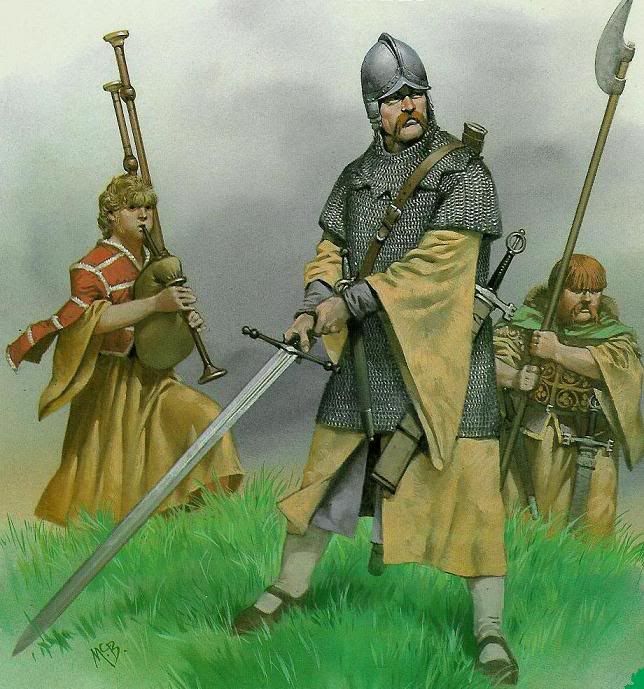
To the English, Ireland was one of the frontiers of Europe, a land on the edge of their world, full of barbarians. It is little surprising then that the courtiers of Elizabethan London observed O'Neill's retainers with 'as much wonder as if they had come from China or America,' according to a contemporary chronicler. Indeed, the Celtic party, headed by The O'Neill, presented a fantastic sight. In defiance of previous Tudor legislation, his warriors were wholly Gaelic in appearance. Their hair was long: fringes hanging down to cover their eyes. They wore shirts with large sleeves dyed with saffron, short tunics and shaggy cloaks. Some walked with bare feet, others wore leather sandals. The galloglas carried battle-axes and wore long coats of mail. -- from Celtic Warriors 400 BC - AD 1600 by Tim Newark.
A Galloglass and his kern attendants await their Irish lord, Shane O'Neill, during his visit to the court of Elizabeth I, London, 1562.
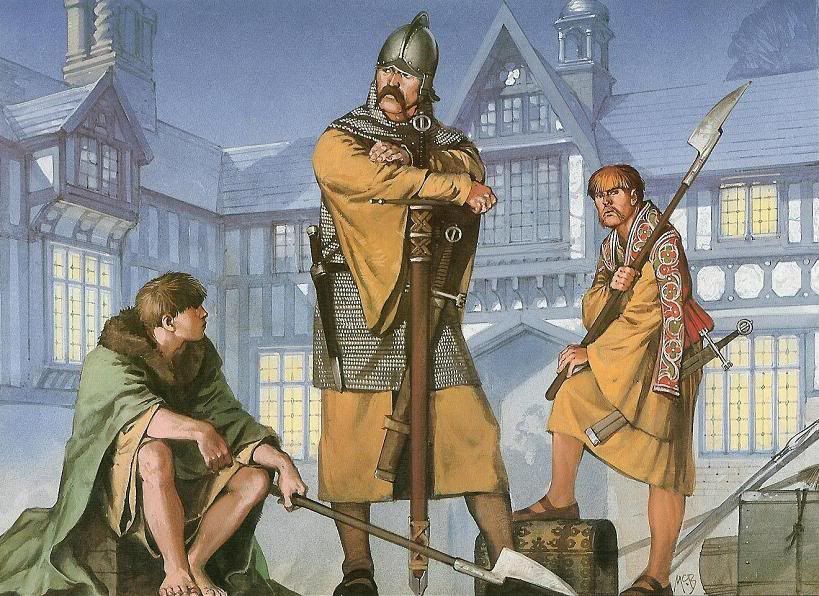
A Border horseman in Ireland battles a Galloglass and a Kern (1576).
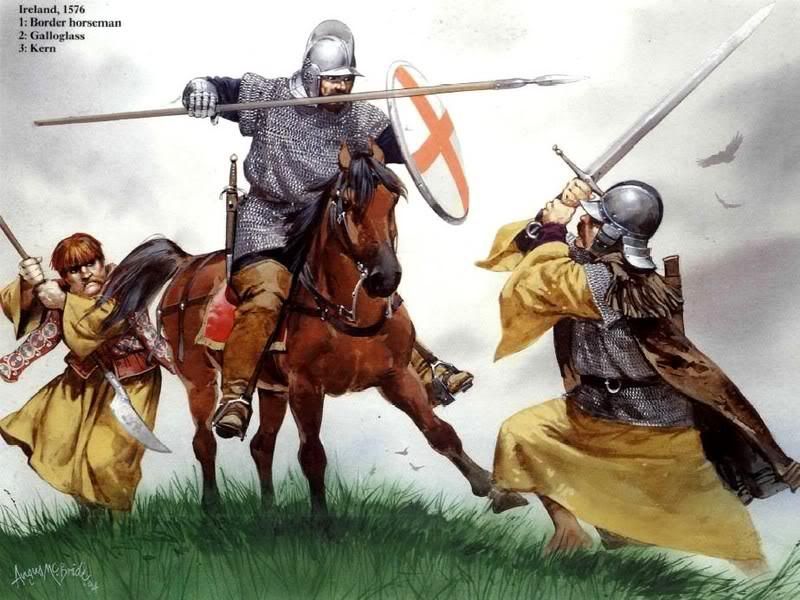
Irish warriors of the army of Hugh O'Neill charge upon the English at the battle of Yellow Ford, Ulster, 1598.
(note: the figure to the left is not wearing an early kilt, but rather a form of the léine, either shortened or drawn up. Very similar to the léine worn by the defiant Irish messenger in Derricke's plate 7, as well as figures in plates 1 thru 4 above.)

A modern recreation of an Irish Kern by a member of Claíomh (meaning 'sword' in the Gaelic) a military 'living history' group based in Ireland.
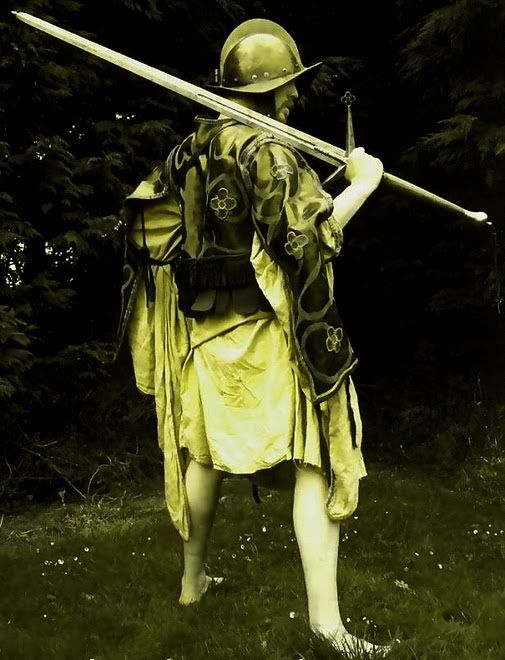
Finally, to read more about the Léine see this online article authored by our own Matt Newsome.
Last edited by BoldHighlander; 15th January 11 at 07:00 PM.
[SIZE="2"][FONT="Georgia"][COLOR="DarkGreen"][B][I]T. E. ("TERRY") HOLMES[/I][/B][/COLOR][/FONT][/SIZE]
[SIZE="1"][FONT="Georgia"][COLOR="DarkGreen"][B][I]proud descendant of the McReynolds/MacRanalds of Ulster & Keppoch, Somerled & Robert the Bruce.[/SIZE]
[SIZE="1"]"Ah, here comes the Bold Highlander. No @rse in his breeks but too proud to tug his forelock..." Rob Roy (1995)[/I][/B][/COLOR][/FONT][/SIZE]
-
-
15th January 11, 03:00 AM
#8
 Originally Posted by BoldHighlander

[FONT="Georgia"][COLOR="DarkGreen"]
Excerpted from "Tartans and Kilts" by the Ulster-Scots Agency:
The trews had been made up from tartan woven in the Donegal style, in strips varying in width and distance from each other. The remaining items were also subjected to rigorous analysis.
Audrey Henshall (Edinburgh's National Museum of Antiquities) concluded that while the mantle was Irish, the trews almost certainly originated in the Highlands. The logical explanation was that tartan cloth woven in Donegal had been exported to Scotland. There the material had been made into tartan trews, which was the fashion in the Highlands. These trews started off as clothing for some wealthy person. When they unearthed in the soil at Flanders townland, the trews were covered in patches. The large variety of materials used indicated that the trews had been passed from one person to another, adding to the mystery.
I'm not really sure whether one can identify any such thing as a Donegal style of tartan and I find it fanciful to assume that if the cloth were indeed woven in Ireland that it would need to be sent to Scotland to be made into trews.
I am unfamilar with any accurate/authorative evidence to support tartan weaving in Ireland during the early 1600s and it's equally possible (probable?) that the material was woven, and possibly made up, in Scotland. We don't even know if the wearer was Irish or one of the Galloglaass. The latter would certainly be logical.
Does anyone have access to Audrey Henshall's article?
-
-
15th January 11, 03:19 AM
#9
While it would be nice to see more evidence and the like I can't see a tartan like material being made in Ireland and then exported. Many areas independently produced tartan pattern cloth.
However I do agree that according to the evidence thus far it is the less likely.
Also, thanks boldhighlander you put in a lot of work posting all that.
Cheers
-
-
15th January 11, 03:52 AM
#10
This reminds me of a Shakespeare quote from Macbeth which is close to my heart.
"The mercilesse Macdonwald
(Worthie to be a Rebell, for to that
The multiplying Villanies of Nature
Doe swarme vpon him) from the Westerne Isles
Of Kerns and Gallowglasses is supply'd ; "
-
Similar Threads
-
By BoldHighlander in forum The Heraldry Forum
Replies: 27
Last Post: 26th July 10, 01:01 PM
-
By cessna152towser in forum Show us your pics
Replies: 11
Last Post: 30th August 06, 12:29 PM
-
By Freedomlover in forum Show us your pics
Replies: 17
Last Post: 14th March 06, 04:20 AM
-
By James in forum General Kilt Talk
Replies: 6
Last Post: 5th June 05, 03:16 PM
Tags for this Thread
 Posting Permissions
Posting Permissions
- You may not post new threads
- You may not post replies
- You may not post attachments
- You may not edit your posts
-
Forum Rules
|
|




















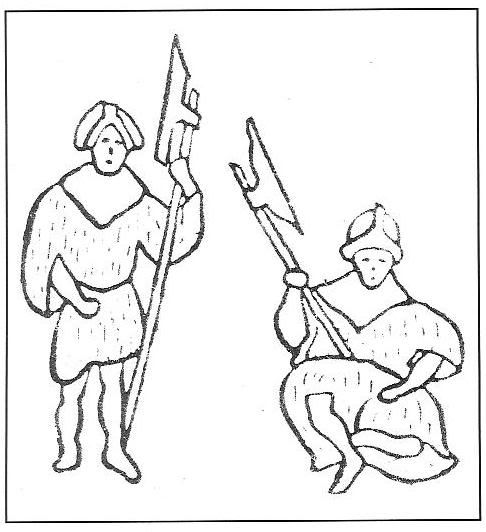
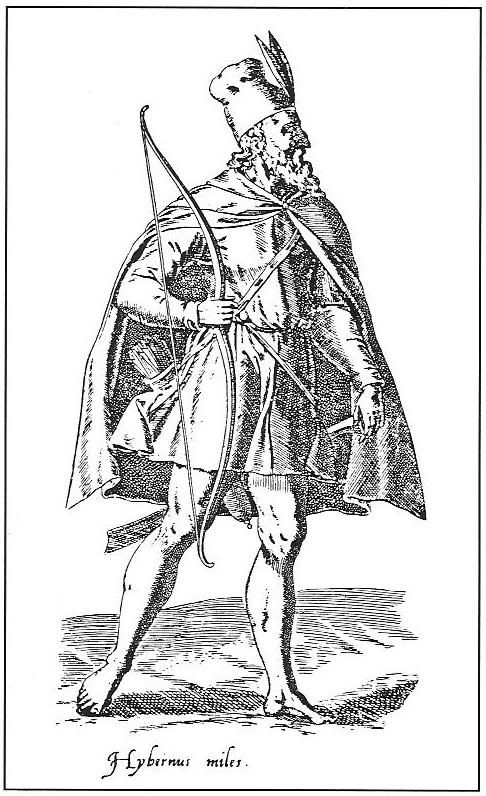
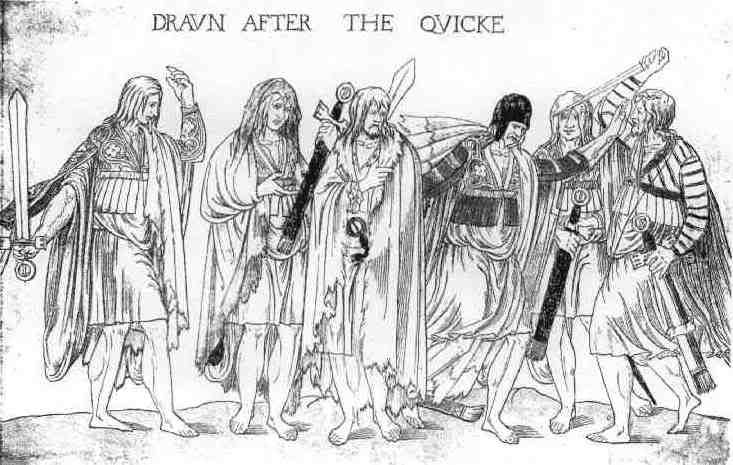
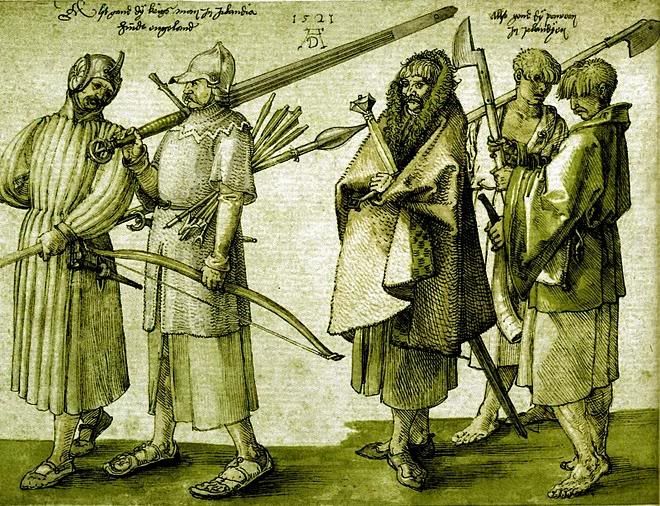
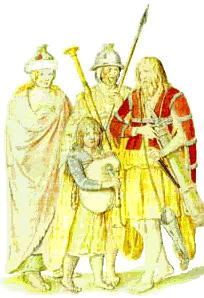
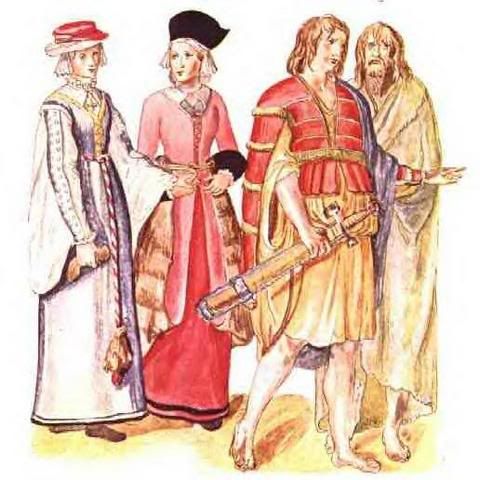
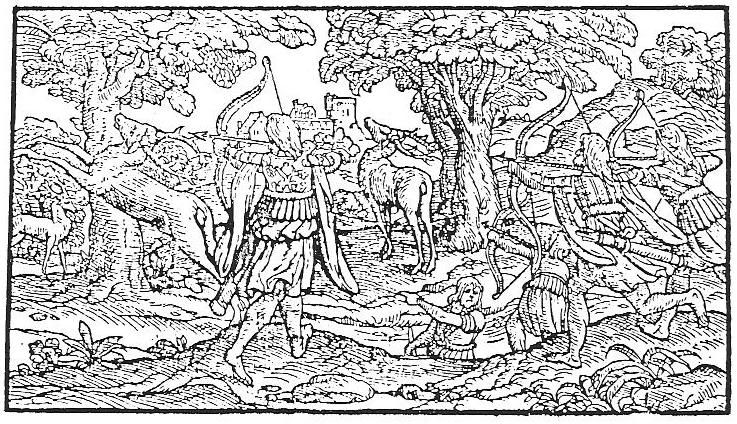
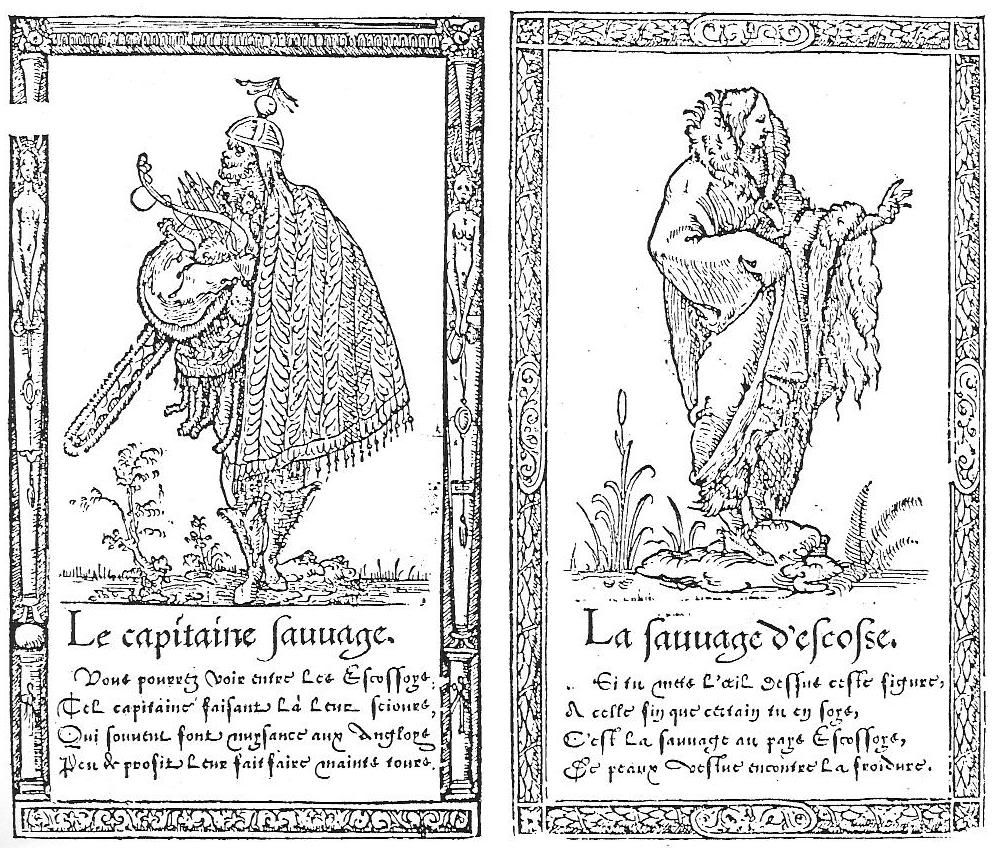



















Bookmarks